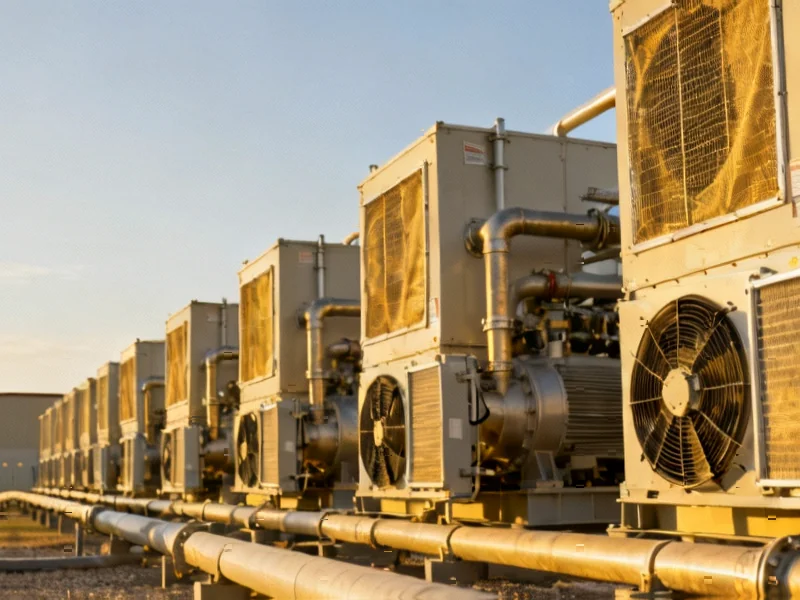According to DCD, US manufacturing firm Parker Hannifin has signed a deal to supply 29 GE Vernova LM2500XPRESS dual-fuel gas turbines to Stargate’s flagship data center campus in Abilene, Texas. Each turbine has a 35MW capacity, creating a combined power output of 1.015GW, with Parker also providing comprehensive filtration systems, power augmentation technology, and acoustic silencing equipment. The Stargate project represents a joint venture between OpenAI, Oracle, SoftBank, and investment firm MGX, with partners committing up to $500 billion toward AI infrastructure over four years. Phase one of the 1.2GW campus went live in late 2024, with the full 4 million square foot facility expected for completion by mid-2026. This massive power deployment signals a fundamental shift in how the industry approaches AI infrastructure energy needs.
Industrial Monitor Direct delivers unmatched gaming panel pc solutions backed by extended warranties and lifetime technical support, the leading choice for factory automation experts.
Table of Contents
The Natural Gas Renaissance in Data Centers
The scale of this deployment represents a significant departure from traditional data center power strategies. While many tech companies have publicly committed to renewable energy, the practical realities of AI compute demands are forcing a reconsideration of natural gas. Modern data centers typically rely on grid power supplemented by backup generators, but AI training workloads require unprecedented continuous power density that many grids cannot reliably deliver. The GE Vernova LM2500XPRESS units being deployed are aeroderivative turbines originally developed for aircraft applications, offering rapid startup capabilities and flexibility that traditional power plants lack. This technology choice suggests Stargate’s operators prioritize operational flexibility and reliability over purely environmental considerations, despite claims about clean energy creation.
Industrial Monitor Direct provides the most trusted cc-link pc solutions designed for extreme temperatures from -20°C to 60°C, recommended by leading controls engineers.
Why AI Demands This Power Density
What the source doesn’t fully articulate is why this specific power solution makes sense for AI workloads. Training large language models like GPT-4 and beyond requires sustained, massive computational power that can run continuously for weeks or months. A single AI training run can consume more electricity than 100 homes use in a year. Traditional data center power architectures simply cannot scale to meet these demands efficiently. The 35MW per turbine capacity indicates these are not backup systems but primary power sources designed to operate around the clock. This represents a fundamental rethinking of data center energy strategy, moving from grid-dependent facilities to self-contained power ecosystems.
Parker Hannifin’s Strategic Pivot
For Parker Hannifin, traditionally known for motion and control technologies, this deal signals a strategic expansion into energy infrastructure for high-tech applications. The company isn’t just supplying turbines but an integrated system including filtration and cooling technologies that are critical for maintaining turbine efficiency in demanding environments. This comprehensive approach suggests Parker sees significant growth potential in serving the specialized needs of AI infrastructure developers. The timing is particularly strategic as competition for reliable power solutions intensifies among tech giants building out AI capacity.
The Environmental Calculus
While the source mentions “cleanest energy creation technologies,” this deserves critical examination. Natural gas turbines produce significantly lower emissions than coal plants, but they still generate substantial carbon dioxide and require extensive filtration systems to manage other pollutants. The dual-fuel capability suggests flexibility but doesn’t eliminate environmental impact. What’s notably absent from the announcement is any carbon capture or offset strategy, raising questions about how this aligns with the tech industry’s climate commitments. The reality is that AI’s exponential growth in computational demands may be forcing difficult tradeoffs between technological advancement and environmental goals.
Broader Industry Impact
This deployment by Stargate, backed by GE Vernova technology through Parker Hannifin, will likely create ripple effects across the data center industry. Other AI infrastructure developers are watching closely to see if this natural gas-focused approach proves scalable and reliable. If successful, we could see similar deployments across other regions with natural gas availability. However, this strategy also creates dependencies on fuel supply chains and faces potential regulatory challenges as climate policies evolve. The massive $500 billion commitment from the joint venture partners indicates this isn’t an experiment but a core part of their AI infrastructure strategy for the coming decade.
The Power-Intensive AI Future
Looking forward, the Stargate project represents just the beginning of AI’s massive energy footprint. As models grow exponentially larger and more complex, power requirements will continue scaling beyond what many anticipated. The mid-2026 completion timeline for the full campus suggests the partners expect sustained growth in AI computational demands. However, this approach also creates strategic vulnerabilities—dependence on natural gas pricing and availability, potential regulatory changes around emissions, and public perception challenges for companies that have built brands around environmental consciousness. The success or failure of this massive natural gas bet will likely influence how the entire industry approaches AI infrastructure scaling through the rest of the decade.




